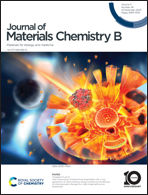Flexible electrochemical sensor for highly sensitive and selective non-enzymatic detection of creatinine via electrodeposited copper over polymelamine formaldehyde†
Abstract
A non-enzymatic electrochemical biosensor was developed for highly sensitive detection of creatinine using copper nanoparticles supported over polymelamine formaldehyde. The synergy between the electrodeposited copper nanoparticles over the highly porous polymer (eCu-PMF) provided a greener platform to boost up the electron transport at the electrode electrolyte interface by eliminating the role of redox species as well as interference of major interferents like glucose, dopamine, and ascorbic acid in physiological media 0.1 M PBS (pH 7.4). The proposed sensor exhibited a wide detection range of 100 fM–60 mM with high sensitivities of 0.320 mA nM−1 cm−2 and 3.8 mA nM−1 cm−2. Moreover, the sensor was applied to real samples of serum creatinine and recoveries of 97 to 114% were found. Additionally, a paper-based flexible screen-printed electrode was fabricated which displayed an excellent activity with the same detection range of 100 fM–60 mM and long-term storage stability of 15 days.



 Please wait while we load your content...
Please wait while we load your content...